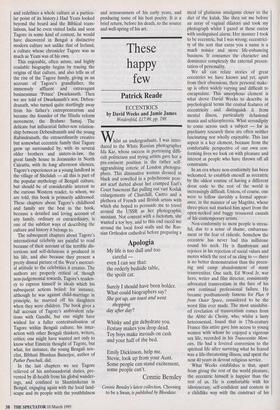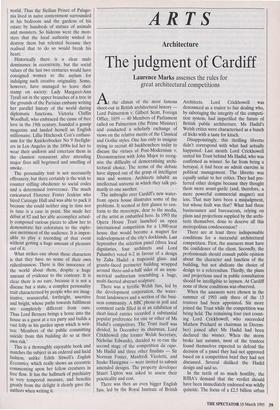These happy few
Patrick Reade
ECCENTRICS by David Weeks and Jamie James Weidenfeld, £17.99, pp. 198 Whilst an undergraduate, I was intro- duced to the White Russian photographer Ida Kar, whose success in portraying diffi- cult politicians and trying artists gave her a pre-eminent position in the rather self- aggrandising coterie of London photogra- phers. This diminutive woman dressed in black and towelled in a polychromic peas- ant scarf darted about her cramped Earl's Court basement flat pulling out vast Kodak enlargements of Churchill, Castro and a plethora of French and British artists with which she hoped to persuade me to travel around the USSR as her photographic assistant. Not content with a factotum, she wanted a toy boy, and to this end raced me around the local food stalls and the Rus- sian Orthodox cathedral before preparing a
Apologia
My life is too dull and too careful - even I can see that: the orderly bedside table, the spoilt cat.
Surely I should have been bolder. What could biographers say? She got up, ate toast and went shopping day after day?
Whisky and gin dehydrate you. Ecstasy makes you drop dead. Toy boys make inroads on cash and your half of the bed.
Emily Dickinson, help me.
Stevie, look up from your Aunt. Some people can stand excitement, some people can't.
Connie Bensley
Connie Bensley's latest collection, Choosing to be a Swan, is published by Bloodaxe. meal of glutinous amalgams closer to the diet of the kulak. She then sat me before an array of vaginal dilators and took my photograph whilst I gazed at these curios with undisguised alarm. Her manner I took to be eccentric, but I was wrong; eccentrici- ty of the sort that earns you a name is a much noisier and more life-enhancing business. It consumes the character and dominates completely the external presen- tation of personality.
We all can relate stories of great eccentrics we have known and yet, apart from their obsessions, their personal make- up is often widely varying and difficult to encapsulate. This amorphous element is what drove David Weeks to describe in psychological terms the central features of eccentricity and distinguish it from mental illness, particularly delusional mania and schizophrenia. What serendipity to come across such a subject — for in psychiatry research these are often neither fascinating nor wholly enjoyable. This last aspect is a key element, because from the comfortable perspective of our own con- forming lives we look on with pleasure and interest at people who have thrown off all constraints.
In an era where non-conformity has been welcomed, to establish oneself as eccentric by the oldest routine of having a different dress code to the rest of the world is increasingly difficult. Unless, of course, one were to follow slavishly a formal appear- ance, in the manner of say Magritte, whose three-piece suit marked him apart from the open-necked and baggy trousered casuals of his contemporary artists.
Non-conformity to most people is stress- ful, due to a sense of shame, embarrass- ment or the fear of ridicule. Somehow the eccentric has never had this millstone round his neck. He is flamboyant and rejoices in his rejection of social values and mores which the rest of us cling to — there is no better demonstration than the preen- ing and camp abandonment of many transvestites. One such, Ed Wood Jr, war hero, writer and film director, consistently advocated transvestism in the face of his own continual professional failure. He became posthumously famous for Plan 9 from Outer Space, considered to be the worst film ever made. The most uninhibit- ed revelation of transvestism comes from the Abbe de Choisy, who, whilst a lusty heterosexual, found that in 17th-century France this attire gave him access to young women with whom he enjoyed a vigorous sex life, recorded in his Transvestite Mem- oirs. He had a fevered conversion to the spiritual life after surviving what he feared was a life-threatening illness, and spent the next 40 years in devout religious service.
What Weeks establishes is that, apart from giving the rest of the world pleasure, the eccentric himself is happier than the rest of us. He is comfortable with his idiosyncrasy, self-confident and content in a childlike way with the construct of his world. Thus the Sicilian Prince of Palago- nia lived in naive contentment surrounded in his bedroom and the gardens of his estate by hundreds of statues of animals and monsters. So hideous were the mon- sters that the local authority wished to destroy them but relented because they realised that to do so would break his heart.
Historically there is a clear male dominance in eccentricity, but the social values of the last two centuries would have consigned women to the asylum for indulging such creative originality. Some, however, have managed to leave their stamp on society: Lady Margaret-Ann Tyrall sat in the upper branches of a tree in the grounds of the Parisian embassy writing her parallel history of the world during diplomatic functions. Victoria Claffin Woodhall, who embraced the cause of free love in the 19th century, founded a gossip magazine and landed herself an English millionaire. Lillie Hitchcock Coit's enthusi- asm for the Knickerbocker No 9 firefight- ers in Los Angeles in the 1890s led her to wear their uniform and entertain them in the classiest restaurant after attending major fires still begrimed and smelling of smoke.
The personality trait is not necessarily effrontery, but there certainly is the wish to counter stifling obedience to social codes and a determined irreverence. The much caricatured Florence Foster Jenkins who hired Carnegie Hall and was able to pack it because she could neither sing in time nor in tune is a case in point. She made her debut at 82 and her able accomplice actual- ly composed various pieces to allow her to demonstrate her coloratura to the explo- sive merriment of the audience. It is impos- sible to play a recording of that event without getting a huge amount of pleasure out of it.
What strikes one about these characters is that they have no sense of their own ridiculousness. There is this innocence of the world about them, despite a huge amount of evidence to the contrary. It is clear there is no cure, because it is not a disease but a state, a complex personality trait characterised by people who are imag- inative, resourceful, forthright, assertive and bright, whose paths towards fulfilment are completely different from ours. Thus Lord Berners brings a horse into the house as a guest at a tea party and builds a vast folly in his garden upon which is writ- ten: 'Members of the public committing suicide from this building do so at their own risk.'
This is a thoroughly enjoyable book and matches the subject in an ordered and lucid fashion, unlike Edith Sitwell's English Eccentrics, which really shows an eccentric commenting upon her fellow creatures in free flow. It has the hallmark of psychiatry in very tempered measure, and benefits greatly from the delight it clearly gave the authors when writing it.



























































 Previous page
Previous page